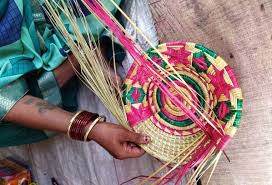Craft Chronicles: Weaving a New Tapestry for India’s Endangered Handicrafts

Do you know that India is home to a rich tapestry of handicrafts, each one a testament to the ingenuity, creativity, and cultural heritage of our artisans? From the intricate weaves of Kinnauri shawls to the exquisite metalwork of Bidri, these crafts have stood the test of time, but now face the threat of extinction. Get ready to embark on a captivating journey through the chronicles of India's endangered handicrafts, where every stitch, every stroke, and every molten drop tells a story of resilience and passion.
The Kinnauri Shawls – Warmth and Artistry Interwoven
Nestled in the remote valleys of Himachal Pradesh, the Kinnauri shawls are more than just cozy wraps; they are living canvases of intricate designs and vibrant colors. As you run your fingers across the soft wool, you'll be amazed by the intricate patterns that adorn these shawls, each one a testament to the skill and patience of the Kinnauri weavers. But wait, there's more! You'll be fascinated to learn that these shawls are not just functional garments; they hold deep cultural significance, with each motif representing the region's rich heritage and symbolic meanings.
The Mystic Allure of Bidri Metalwork
Journey to the historic city of Bidar, where the age-old tradition of Bidri metalwork has captivated artisans and connoisseurs alike for centuries. Prepare to be mesmerized by the intricate patterns and designs that adorn these exquisite metalworks, each one a testament to the skilled hands of the Bidri craftsmen. Not only is this craft a visual feast, but it also holds deep spiritual significance, with many of the motifs and symbols rooted in ancient Sufi traditions and Islamic calligraphy.
The Vibrant Hues of Kalamkari
Immerse yourself in the world of Kalamkari, a centuries-old textile art form that hails from the vibrant state of Andhra Pradesh. Prepare to be captivated by the intricate patterns and vibrant hues that adorn these hand-painted fabrics, each one a labor of love and a testament to the artisans' mastery over natural dyes and intricate brushwork. But wait, there's more! You'll be amazed to learn that the art of Kalamkari was once a closely guarded secret, with each motif and technique passed down through generations of skilled artisans.
The Sculptural Splendor of Jalari Craft
Venture into the remote villages of Jharkhand, where the Jalari craft has been a source of pride and livelihood for generations of artisans. Prepare to be awestruck by the intricate sculptures and figurines crafted from horse hair and bamboo, each one a testament to the ingenuity and patience of the Jalari craftsmen. Not only are these creations visually stunning, but they also hold deep cultural significance, depicting scenes from local folklore and the region's rich heritage.
The Artisans' Resilience
As you delve deeper into the chronicles of India's endangered handicrafts, you'll be inspired by the unwavering resilience of the artisans who have dedicated their lives to preserving these age-old traditions. From the weavers of Kinnauri shawls to the Bidri metalworkers, these skilled craftsmen have faced numerous challenges, but their passion for their craft has kept these ancient techniques alive, one stitch, one stroke, and one molten drop at a time.
Weaving a New Tapestry
As we bid farewell to this captivating journey, remember that these endangered handicrafts are not just relics of the past; they are living embodiments of India's rich cultural heritage and the enduring spirit of creativity. It is our collective responsibility to weave a new tapestry, one that celebrates and preserves these age-old traditions, ensuring that the threads of our artisans' skills and passion are never lost. By embracing and supporting these endangered crafts, we can not only safeguard our cultural legacy but also empower the artisans who have dedicated their lives to keeping these ancient techniques alive.